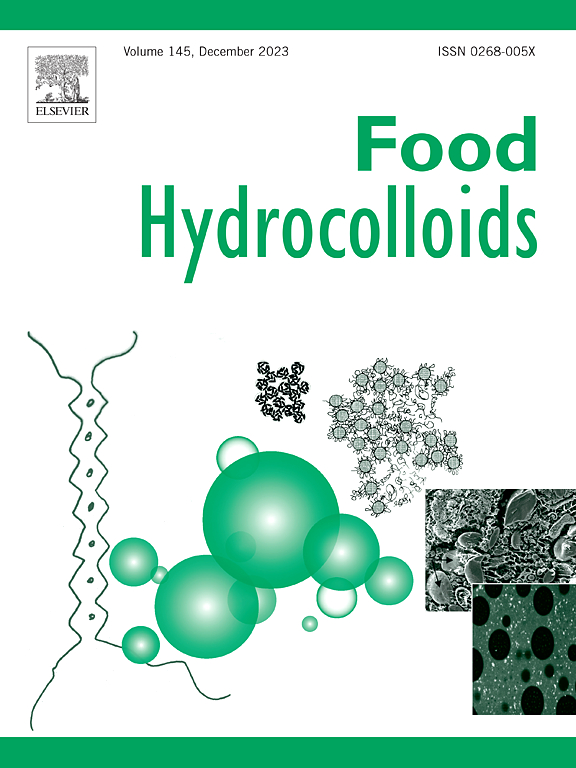Tribological properties and interfacial adsorption behavior of milk protein-based formulations: Roles of whey protein type and thermal processing
IF 11
1区 农林科学
Q1 CHEMISTRY, APPLIED
引用次数: 0
Abstract
Whey protein-associated mouthdrying during oral processing is a driving factor for consumers' dislike of high-protein beverages, however, remains mechanistically underexplored in dairy systems. This study investigated the fundamental mechanisms driving powderiness in whey protein-enriched dairy beverages (8 % w/w protein). We conducted a comparative analysis of whey protein concentrate (WPC) versus whey protein isolate (WPI) at various casein-whey ratios (80:20 to 20:80) and evaluated thermal processing effects (63 °C/85 °C for 30 min) from rheological characterization, particle size distribution, tribological properties, and interfacial adsorption kinetics. Results demonstrated that protein composition significantly altered frictional behavior, with WPC-dominated systems (casein-whey protein ratio of 20:80) exhibiting 33.6 % higher friction coefficients versus WPI counterparts at 10 mm/s without heating. Thermal treatment at 85 °C induced substantial aggregation in WPI-dominant systems (hydrodynamic diameter increased from 0.150 μm to 0.167 μm) and reduced adsorption capacity by 30.80 %, correlating with impaired lubrication. Conversely, WPC maintained structural homogeneity and enhanced interfacial coverage post-heating, preserving lubrication functionality. These findings establish composition-specific thermal processing guidelines for optimizing sensory attributes in high-protein dairy beverages.

乳蛋白基配方的摩擦学性能和界面吸附行为:乳清蛋白类型和热处理的作用
在口腔加工过程中,乳清蛋白相关的口腔干燥是消费者不喜欢高蛋白饮料的一个驱动因素,然而,在乳制品系统中,这一机制仍未得到充分探索。本研究探讨了乳清蛋白富集乳饮料(8% w/w蛋白)的粉状性的基本机制。我们进行了乳清浓缩蛋白(WPC)和乳清分离蛋白(WPI)在不同酪蛋白-乳清比例(80:20到20:80)下的对比分析,并从流变学表征、粒度分布、摩擦学性能和界面吸附动力学等方面评估了热处理效果(63°C/85°C 30 min)。结果表明,蛋白质组成显著改变了摩擦行为,wpc主导的体系(酪蛋白与乳清蛋白的比例为20:80)在不加热的情况下,在10 mm/s的速度下,摩擦系数比WPI高33.6%。85°C的热处理导致wpi为主的体系中大量聚集(流体动力直径从0.150 μm增加到0.167 μm),吸附容量减少30.80%,与润滑受损相关。相反,WPC在加热后保持结构均匀性和增强界面覆盖,保持润滑功能。这些发现为优化高蛋白乳制品饮料的感官属性建立了特定成分的热处理指南。
本文章由计算机程序翻译,如有差异,请以英文原文为准。
求助全文
约1分钟内获得全文
求助全文
来源期刊

Food Hydrocolloids
工程技术-食品科技
CiteScore
19.90
自引率
14.00%
发文量
871
审稿时长
37 days
期刊介绍:
Food Hydrocolloids publishes original and innovative research focused on the characterization, functional properties, and applications of hydrocolloid materials used in food products. These hydrocolloids, defined as polysaccharides and proteins of commercial importance, are added to control aspects such as texture, stability, rheology, and sensory properties. The research's primary emphasis should be on the hydrocolloids themselves, with thorough descriptions of their source, nature, and physicochemical characteristics. Manuscripts are expected to clearly outline specific aims and objectives, include a fundamental discussion of research findings at the molecular level, and address the significance of the results. Studies on hydrocolloids in complex formulations should concentrate on their overall properties and mechanisms of action, while simple formulation development studies may not be considered for publication.
The main areas of interest are:
-Chemical and physicochemical characterisation
Thermal properties including glass transitions and conformational changes-
Rheological properties including viscosity, viscoelastic properties and gelation behaviour-
The influence on organoleptic properties-
Interfacial properties including stabilisation of dispersions, emulsions and foams-
Film forming properties with application to edible films and active packaging-
Encapsulation and controlled release of active compounds-
The influence on health including their role as dietary fibre-
Manipulation of hydrocolloid structure and functionality through chemical, biochemical and physical processes-
New hydrocolloids and hydrocolloid sources of commercial potential.
The Journal also publishes Review articles that provide an overview of the latest developments in topics of specific interest to researchers in this field of activity.
 求助内容:
求助内容: 应助结果提醒方式:
应助结果提醒方式:


